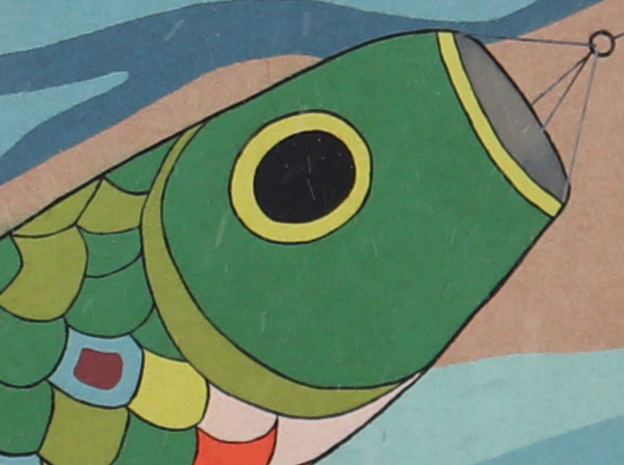Activating the urban environment: A case for street art
Alix Beattie
Western Sydney University
Abstract
Street art engages audiences like few other art forms. It appears in the everyday, capturing our attention and seeking communication with, and from, audiences. Artists use the urban environment as a canvas to create artworks that reflect life and respond to events around them. For example, a recent article in the New York Times highlighted street artist responses to the Covid19 pandemic (Suri, 2020) and The New Yorker outlined how street artists connected communities during the Black Lives Matter protests (Wright, 2020). This paper discusses the way street art has been used to activate the urban environment through urban renewal, audience engagement and the use of street art tours. This study focuses on how Laramie (Wyoming), a small town in the US, has used street art murals to activate their small downtown. I begin by outlining my personal journey, then outline how Martin Heidegger’s concept of the ‘threshold’ can potentially impact on audiences of street art, before discussing the case study in detail.
Laramie, Wyoming: A conservative town with artistic sensibilities
Wyoming is the tenth largest state by area in the USA, but with only a relatively small population of 567,000 (‘Wyoming, USA: State specific information,’ 2019). While a deeply conservative state, it also has a proud progressive history which includes Louisa Gardner Swain, who in Laramie in 1870 became the first woman to vote in full equality with men (Funk, 2019). Laramie, itself has a population of approximately 32,000 (‘Wyoming, USA: State specific information,’ 2019). Unlike many other towns in Wyoming, Laramie’s economy is not focused on extractive industries but on education (with both the University of Wyoming and a Laramie County Community college) and other service industries including healthcare and hospitality (‘Wyoming, USA: State specific information,’ 2019).
It may seem unlikely, but this small town in a conservative state also provides an example of how street art – specifically murals – can be used to activate the urban environment. From murals that aim to capture Laramie and Wyoming’s complex and controversial history, to works focused on aesthetics, street art has become a fundamental part of the town’s identity. The town not only is home to numerous murals, it also supports historical sculptures, art galleries, artist collectives, cafes and bars.
I lived in Laramie for almost a year from July 2019 and found the town to have a genuine commitment to engaging its community. This is not only obvious in the atmosphere you experience and the many informal conversations I had with community activists, but also evident in the many formal strategies of the local authorities which include a downtown advisory committee with community representatives (Laramie Main Street, n.d).
As a university town, many local businesses rely on the patronage from both the community members and students to ensure a vibrant downtown. This is fundamental in ensuring locally owned businesses thrive. As such, there are a number of initiatives established to collectively keep the town centre flourishing and attractive, including local farmer’s markets, art walks, ‘shop local’ days and the focus of this paper: the mural projects. Such strategies mirror those of other small Australian towns and cities such as Wollongong, NSW – approximately 85 kilometres from Sydney. Like Laramie, Wollongong is also reliant on a large university community and hosts numerous artist-inspired collectives and programs including an annual street art festival. One of the challenges that Laramie faces, however, is harsh and long winters that can repel visitors. Temperatures sit well below 0 degrees celsius between November to April, with –18 degrees celsius days common. The cold winters are characterised by snow and wind speeds that meant as a cyclist, I frequently had to peddle in a low gear to go downhill!
As a tourist destination, Laramie is not on everyone’s holiday bucket list. However, this does not mean tourism does not have an impact locally as the state of Wyoming contains Yellowstone National Park, Grand Teton National Park and the popular skiing resort of Jackson Hole. While Laramie is located on the far side of the state from these attractions, it benefits from many who seek to visit these holiday destinations. Despite this, Laramie is seen as being part of the ‘fly over’ state: that is, people fly across the state often ignoring the beauty it has to offer.
Due to such challenges, the Laramie community has responded with the aim of creating a downtown that attracts local residents, the student body and visitors alike. Murals are situated around the town centre, giving the urban environment active colours instead of the blandness that can characterise the main streets of many similar towns (see Figure 1). It is in this way that the local community continues to use art as a way of activating space. Creating this activated downtown invites travellers, the local community and the broader university community (including the domestic, interstate and international students who live on campus), to stop and enjoy the space, learn about the history of the town and state, and frequent the local businesses.
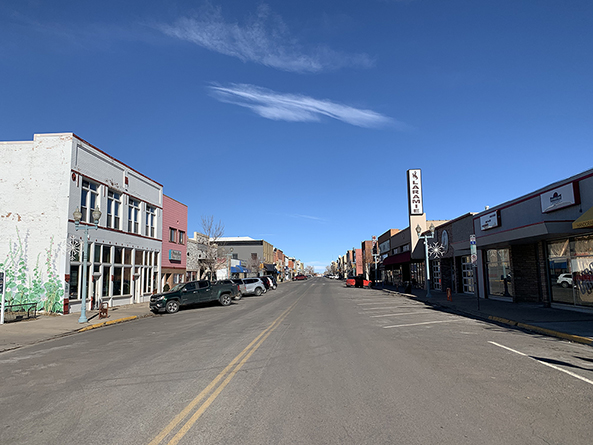
Figure 1. Image of Downtown, 2nd and E Custer Street, Laramie, WY, USA.
Photograph: A. Beattie, January 2020
This paper explores how this town has used street art to activate its small urban downtown environment. Such projects do not happen by accident but require a combination of both planning and establishing an environment where artists can both engage the community and thrive. Before outlining this case study, I will discuss what is unique about street art, its complex definition, how audience interaction is crucial to the art forms and how the media of street art plays a role in urban renewal.
Street art & graffiti: Complex art forms often dismissed as vandalism
Street art and graffiti have emerged as areas of significant academic research over the past two decades (Ross, Bengtsen, Lennon & Wilson, 2017). The research crosses multiple disciplines including but not limited to: law (Young, 2010; Young, 2013; Young, 2014); geography (Iveson, 2010, McAuliffe, 2012), sociology (Biedarieva, 2016; Blanché, 2015), gender studies (MacDonald, 2001; Parisi, 2015) and art history (Chmielewska, 2007). More recently, there has been a focus on this art form as political activism (Arvanitakis & Beattie, 2019), its role in activating public cities through audience engagement (Flessas & Maulcahy, 2018) and in creating urban renewal (Blanché, 2015; Brighenti, 2016; Ulmer, 2017). One theme that emerges across most of these studies is the way these art forms change public space through their disruption of the everyday – a concept I will discuss in greater detail below.
The definition of street art has historically been debated. One frequently cited definition is offered by Ulrich Blanché (2015):
Street art consists of self-authorised pictures, characters and forms created in or applied to surfaces in the urban space that intentionally seek communication with a larger circle of people. Street art is done in a performative and often site-specific, ephemeral and participatory way (p. 33).
This definition does not include the subculture of graffiti, however Blanché recognises that the distinction between street art and graffiti is often blurred. There are multiple similarities between graffiti and street art, though in the context of this paper, the focus is on the way both these art forms specifically seek to communicate to the audience.
This focus on the communicative aspect is also explored by Baird and Taylor (2016) who compare graffiti across time periods – specifically, ancient graffiti of the Graeco-Roman period (c.700 BCE–500 CE) – to contemporary graffiti. Their argument is that across time, the purpose of graffiti has been different forms of communication with its audience. Baird and Taylor (2016) explain that ancient graffiti had multiple purposes including commenting on local politics as well as providing directions and welcoming travellers. In comparison, he says, contemporary forms of graffiti generally aim to communicate between graffiti artists. This communication is specific to those who can read the text and know how to decipher the information. This focus on audience seeking communication is the key to how my own research on street art is framed. In addition to audience communication, my own definition includes two additional dimensions: artwork and location. I will discuss each of these dimensions in turn.
The first dimension relates to street art as ‘artwork’: street art defies the galleries and institutional spaces by allowing artists to create works that are defined only by themselves as artists. These could be murals, graffiti, stencils, sculptures, paste-ups and stickers.
The second dimension relates to ‘location’: street art uses the urban environment as a canvas. Sometimes this canvas is accessed legally (sanctioned) through commissioned works or designated walls. Other times, artists access areas without permission, making the works illegal (un-sanctioned). Spaces within cities that are legislated for use are adopted by street artists to create location-based works that combine both site specific landscapes and concepts. According to Young (2014), this creates cities within cities, with the establishment of ‘…public cities’ (p.57). These ‘public cities’ generate a community for the artists to come together and produce collaborative works. One example is the collaboration project in Gill Street, Laramie. Here is a space designated by public authorities within the town that was used for artists to collaborate and come together under this banner of ‘community’ (see Figures 2, 3, 4, 5, 6).
The third dimension is ‘audience’: this is the key definer between ‘graffiti’ and ‘street art’. Graffiti writers engage other graffiti writers whereas street art engages the general public as the audience (Bentley, 2015). Street art is available for all to see regardless of whether the artwork is sanctioned (legal) or not sanctioned (illegal). It is here that it is important to reiterate Blanche’s (2015) definition of communication: street art breaks the confinements of traditional gallery spaces to create a new sense of engagement for audiences everywhere. This allows for an engagement with the everyday audience and, as I will argue, these interactions assist in activating cities.
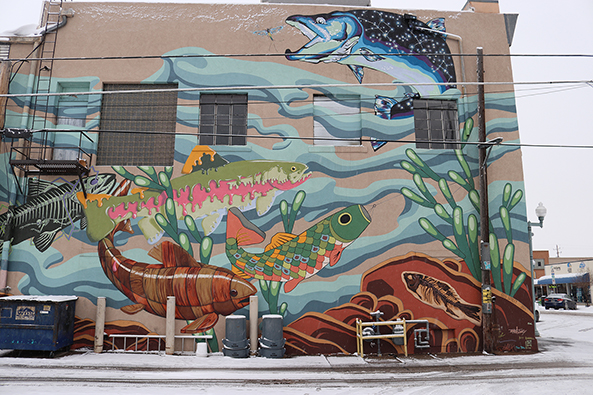
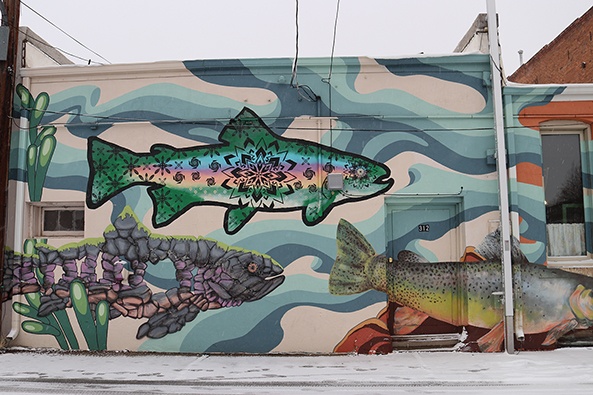
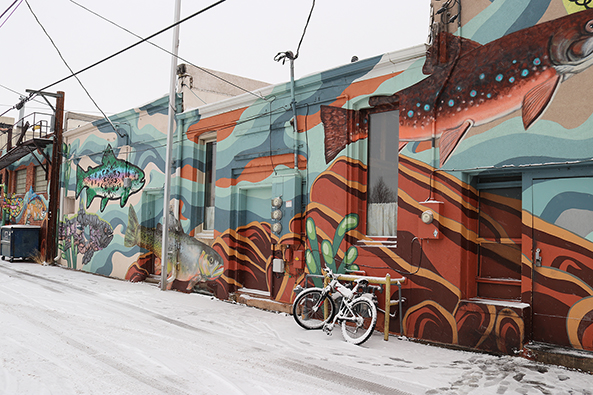
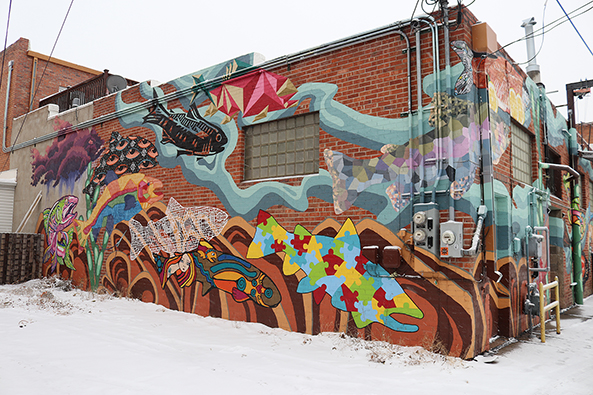
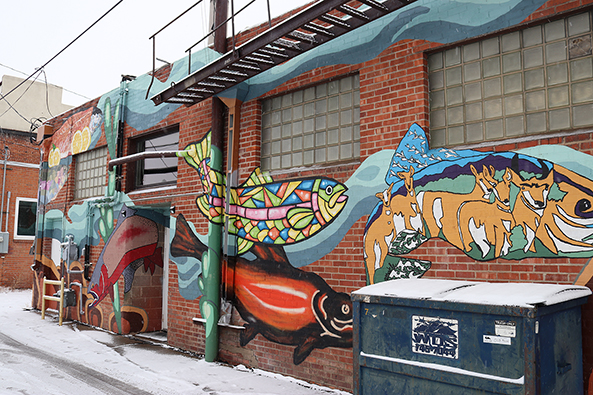
Figure 2, 3, 4, 5, 6. Gill Street Mural, 2014
Artists: Colleen Friday, Jeff Hubbell, Travis Ivey, Evan Levi, Chelsea Lowry, Meghan Meier, Lindsay Olson, Dan Toro, Adrienne Vetter
Photograph: A. Beattie, January 2020
Street art: Crossing the ‘threshold’
As noted above, street art has the ability to activate public space through its disruption of the everyday. Art is used as a way of engaging audiences to see the world differently with the potential of creating a moment of ontological disjuncture. That is, it creates a ‘jolt’ that metaphorically shakes the audience out of their everyday and mundane experiences.
This disruption can be best understood through Martin Heidegger’s (1927/1962) discussion of dasein – that is, the experience and existence of us as human beings. Specifically, Heidegger’s focus is on the experiences that have the capacity to shape our existence. Steiner (1978) extends Heidegger’s discussion of dasein as being related to physical beings in the everyday. He describes this physicality as being in the moment of the everyday – experiencing our everyday existence through the physicality of movement and sensation.
Heidegger argues that there are moments of engagement that can be projected, stating that:
Meaning’ signifies the ‘upon-which’ [das woraufhin] of a primary projection in terms of which something can be conceived in its possibility as that which it is. Projecting discloses possibilities – that is to say, it discloses the sort of thing that makes possible (1927/1962, p. 371).
From this perspective of the ‘possible’, a moment can be conceived as crossing the ‘threshold’. This is the moment of disjuncture that creates the possible – and it is this moment where a potential disruption is created by street art.
The physicality of being in the everyday creates a way of understanding the role of the artists within society. Artworks are representations of the artist’s thoughts and creativity (Carroll, 1999). Rather than being disconnected as is often portrayed in the popular media, artists are deeply present and observing the world around them, creating works that visually engage the audience by reflecting how they interpret their subjects.
This is echoed by Richard Wollheim (1970) who expands on the concept of representation and discusses art as having both meaning and context. Here Wollheim is including audiences and how they are open to interpretations of what is reflected in the work, creating a dialogue with the viewer and artist. The artist can force us to reflect, and in such moments, this alters the audience’s contemplation of what they are viewing (Arvanitakis & Beattie, 2019). Artists guide audiences to unpack and engage with the world through the imagery of artworks on an alternative level, moving the physical being into a space that disrupts this every day.
This concept of art as a representation and creator of a dialogue is developed by O’Doherty (1986) when discussing the art gallery as a mediated and an intentional space. As an audience member you attend a gallery and you engage with art, walking through, interpreting, reflecting, and as a result, creating a dialogue with the artist. This dialogue is not only mediated by the gallery, but generally anticipated by the audience. It is here that we can draw a sharp distinction between the formal gallery and the ‘gallery’ which exhibits the work of street artists. Street art is rarely mediated or anticipated – and it is for this reason that disruption and the threshold moment occur. While moments of disruption can occur within the gallery, the mediated and anticipated nature of the experience can limit any impact. In contrast, street art breaks daily habitual and mundane moments, creating a disruption. The context is dramatically different, and it is here that Steiner’s (1978) description of physicality of experiences gives rise to the potential of the threshold moment. The power of street art is that it removes the artwork from within the artificial confines of the gallery. Artists who use the urban environment as a canvas have the potential to create disruptive moments within the everyday. Street art has the potential to disrupt people’s everyday experiences – both those for seeking an artistic experience as well as those with no such interest. This is the alluring nature of street art – it disrupts the everyday – illustrating Heidegger’s moments of experience and existence.
Audience engagement: From the mundane to disrupting the ‘everyday’
As Blanche (2015) and others emphasise, audience engagement is critical to the viewing of street art. Flessas & Maulchay (2018) discuss the way that the viewer takes on the responsibility of the art – something that can be contrasted to traditional galleries that O’Doherty’s (1986) describes as ‘white cubes’. Describing galleries as white cubes is a way of referring to the established and formal setting commonly experienced when viewing art: as noted, galleries are both mediated and curated by professionals who guide the audience through the design, context and provided information. In contrast, street art allows the audience to engage with art outside these constraints and reflect on what is appearing in the urban landscape. As a result, the viewer crosses the threshold, leaving the everyday habitual and mundane experience. This process creates a disruption to the viewer as the art works explode the once bland urban environment with colour, texture and typography.
Artworks that disrupt the everyday activate audience engagement with urban environments. This is because this disruption changes the usual tedious downtown areas of bricks and mortar to a vibrant open-air gallery. This type of engagement is juxtaposed with the way audiences participate with artworks in the traditional space of the white cube gallery (O’Doherty, 1986). The manner in which audiences engage with the works is central to how these art forms activate their urban spaces, and this is different to how we view artworks in a gallery setting. As Flessas et al. (2018) observe, ‘[w]hile the exhibition space tends to discipline us to be docile spectators and to focus on the act of observation, art on the street aims to excite a broader range of senses.’ (p. 234). That is, our senses are challenged in a different way when viewing street art in an alternative environment, rather than in a staged gallery setting. The result is that the audience must respond by creating their own understanding and interpretation that both emerges and confronts them from within an unexpected place. This is the disruption that is created and where the audience crosses the threshold when engaging with art in an unexpected setting.
It is this moment that intrigues us, as an audience, to want to know more about the context of the work that has not been artificially mediated within the confines of a traditional gallery setting. The audience experience is accentuated by the way that street art challenges the senses in an open-air gallery exposed to the elements: changing weather, lighting, noise levels – again something that is reflected in Steiner’s notion of physicality. Such an environment means that the works can be naturally damaged as well as vandalised – as happened recently in Melbourne’s Hosier Lane (Smith, 2020). It is for such reasons that street art can be described as temporary or ephemeral. Artworks come and go within a certain time and space, impacting how we perceive the works, and even whether we get to view them. If they have disappeared, is it possible to connect with what was originally in that space? Further, we are never sure what will appear in the same space in the future.
It is in such an environment that audiences activate the artwork and the environment. This activation is heightened by the impact of the internet and social media which not only promote the work, but allow these ephemeral works to become forever embedded within the digital world (Brown, 2015). This activation also reflects the audience engagement with the artwork and the desire to know more, encouraging the artist and the surrounding community to entice audiences by providing additional information. This extra information brings the traditional gallery information to the public through alternative engagement including street art tours, websites and social media.
This activation has resulted in social media embedding the practices of street artists into the virtual world and has altered the once ephemeral art forms into a documented and preserved digital presence (Brown, 2015). MacDowall and De Souza (2018) discuss how street art and graffiti practices are being reshaped by the use of the internet and social media. Two broader trends that have arisen from their research, are how digital media, including social media, are changing both the experience and the interactions of the audience whilst viewing works in the urban landscape. MacDowall et al. (2018) argue that, ‘Graffiti writers and street artists have enthusiastically taken to Instagram and incorporated it into their everyday practice, both for its aesthetic appeal and as a means of documenting, sharing, and distributing images of their work’ (p.4). Artists are using the internet to communicate by inviting conversations from the audience and other artists.
These conversations make content spreadable. The concept of spreadability refers to the ‘potential – both technical and cultural – for audiences to share content for their own purposes’ (Jenkins, Forg, & Green, 2013, p. 3). Increasingly, these connections are made through social media platforms. Content created by the user that reverberates through the internet allows audiences to communicate and embrace the connections and create new networks with artists for interaction and conversations (Barbour, 2013). As audiences engage through social media, artists can directly communicate with the viewer, explaining their context, motivation and inspiration.
However, the internet and social media have their challenges. Users get lost within what Parisier (2011) refers to as filter bubbles that guide the user and limit experiences. These filter bubbles create echo chambers that both reflect and reinforce our own views rather than challenge our thoughts or expose us to new ideas (Zuiderveen Borgesius et al. 2016). In this way, exchanges can be limited and mediated. While a detailed discussion is outside of the scope of this paper, it is important to note that the internet is used as a way of directing its audiences into these spaces that can guide, and sometime hinder, experience.
Street art as an activation of space
As discussed, street art is commonly thought of as an ephemeral or temporary art form that is used in a way to engage with audiences (Beattie, 2017; Biedarieva, 2016; Hansen & Danny, 2015). It is ephemeral because it is always temporary – open to new commissioned works, including additions or changes by other artists, changes created by local authorities that want the works removed and changes created by vandalism and deterioration by natural elements of sun and rain. This transitory nature of the works adds to the audience experience as they often recognise that it might disappear in a matter of hours.
Further, the disruption potentially created by street art is not just one of aesthetics, but is often coded with layers of messages presented by the artists – sometimes social, sometimes political. As such, the art form escalates the audience’s experience by producing a space for individual engagement, or for audiences to interact and create conversations between the artwork, themselves and the artists.
This engagement has expanded through the use of social media and the internet (Drew, 2012). As such, this once ephemeral artwork is now embedded into the virtual world which documents these creations making these temporary works last within the digital space for years to come (Young, 2014). Technology is assisting this interaction by activating these spaces, be they cities or communities and social media can be used to create further engagement and hype.
The significance of artists who use street art as a medium is to create artworks in the urban environment that activate the cities in which their artworks sit. However, this activation is creating both positive and negative effects. As street art is classified as ‘post-graffiti’ (Dickens, 2008), a negative outcome can be seen through the influence of the media and how vandalism has long been associated with graffiti (Ten Eyck, 2016) thus creating a negative stigma. This can be seen in ways that the urban renewal concept of street art is being used to battle this negative outlook. As mentioned above by Young (2014), the medium of street art is there to create a sounding board for artists to simultaneously create works within these public cities and to activate the spaces in which they sit.
Urban renewal: Altering the visual landscape
Graffiti and street art offer dialogues that create conversations within the community (Christensen & Thor, 2017). These dialogues include how street art can be used as a tool for an urban renewal process. By engaging with art in the urban environment, the surroundings become a place for art to be viewed in the everyday. As I have argued, street art creates a vibrancy that encourages the activation of urban space.
This activation is a complex process. Christensen et al. (2017) argue that we have also seen the commodification of this media which, as a consequence, has changed the communities in which these sit. This commodification has been seen as a double-edged sword: creating a gentrification that is revitalising neglected neighbourhoods while simultaneously creating demand for properties resulting in inflationary pressures that can displace residents and force out the artists using the space. Brighenti (2016) who views the gentrification through a Marxist analysis of street art, discusses the impacts that the valorisation of the art form can have on property prices and how this potentially shifts citizens from their communities, displacing those that are economically vulnerable. This downside of the gentrification of suburbs is debated by Blanché (2015) who outlines the positive impacts of the reshaping of neighbourhoods with the potential of neighbourhoods being revitalised through the artworks on the street.
As Blanché (2015) outlines, the art form that sits within our urban environment has the ability to alter the urban landscape whilst engaging the surrounding neighbourhood community by bringing new people and artists into the area. One example of positive gentrification is a house in Newtown, Sydney Australia, that was re-built and has an exposed wall for the use of artists within the community (see Figure 7 & 8).
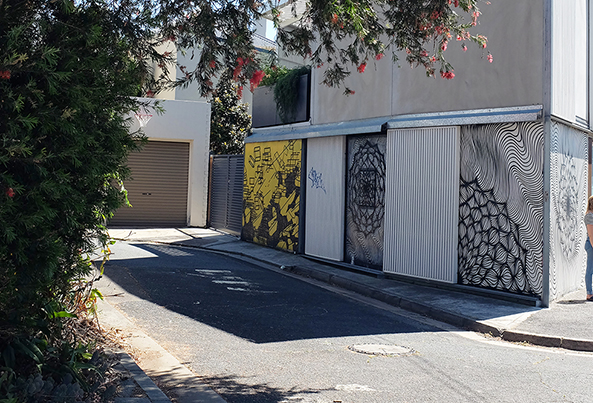
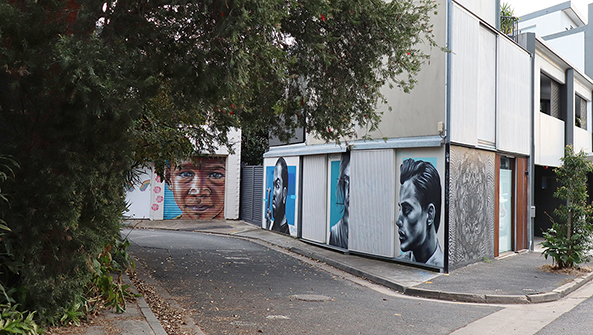
Figure 7. Image of a house in Newtown, NSW, Australia.
Photograph: A. Beattie, May 2017
Figure 8. Image of a house in Newtown, NSW, Australia.
Photograph: A. Beattie, June 2020
Another example of positive gentrification is captured by Victoria’s official tourism organisation, VIC Tourism, which promotes Melbourne’s street art culture in order to attract tourists to Hosier Lane, a specific downtown area where artists can create works in without invoking the laws that surround street art. As stated on VIC tourism website, ‘The City of Melbourne recognises the importance of street art in contributing to a vibrant urban culture’ (City of Melbourne, n.d) (see Figure 9). One dimension here is that the ephemeral nature of the art form (and as a consequence the neighbourhoods), means they are constantly changing and evolving. The aim is to activate the urban environment by providing as space for local artists to create works.
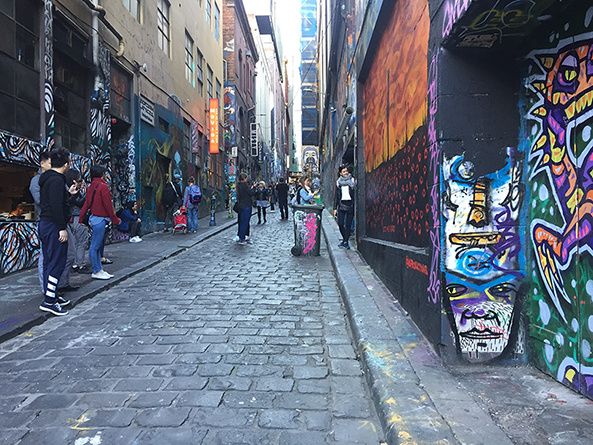
Figure 9. Image of Hosier Lane, Melbourne, VIC, Australia.
Photograph: A. Beattie, August 2017
This creation of works within the city terrain is accompanied by several tensions. In addition to the commercialisation and potential displacement outlined above, there are also anxieties that emerge between what is public and what is private property. As Ulmer notes, ‘[t]ensions between public and private play out in the streets, street artists claim visible space through multiply forms of art, including signage and other forms of post graffiti’ (2017 p. 491).
It is through this discussion that Ulmer (2017) directs the audience to the complexities of street art in revitalising neighbourhoods of Detroit, Michigan. In such locations, artists inscribe the streets of the urban environment with commentary on social and economic justice. As they do this, the artists create tensions by challenging this public and private property divide. Street artists use the medium to connect with audiences about what they see as important issues that are currently facing the city.
As street artists use the urban environment to communicate with their audience, it is from here that the activation of space occurs. Audiences become intrigued by what the artists are trying to communicate, and it is through this fascination that we see how street art tours have emerged as a popular tourist activity that is creating an urban renewal through this process.
Street art tours: Beyond sightseeing
Activation creates engagement with street art through tours that are widely available in many parts of the world (Bombing Science, 2017). People are engaging and wanting to know more about this medium, by visiting cities and using these tours as part of their travel plans. This is explained in Andron’s (2018) analysis of the London suburb of Shoreditch, United Kingdom. Street art tours are creating a sense of engagement with the artists and visitors, suburbs experience positive economic benefits, and places that would not normally attract tourist traffic are thriving. As people take these tours, they are seeing different areas and engaging with a suburb and other local businesses.
In addition to generating business for local traders, artists creating works within these areas allow the audience to interact and view their works without spending money or having to attend a gallery space (Christensen et al,. 2017). The urban environment is the gallery and combining with the tours is creating business for these areas (see Figure 10).
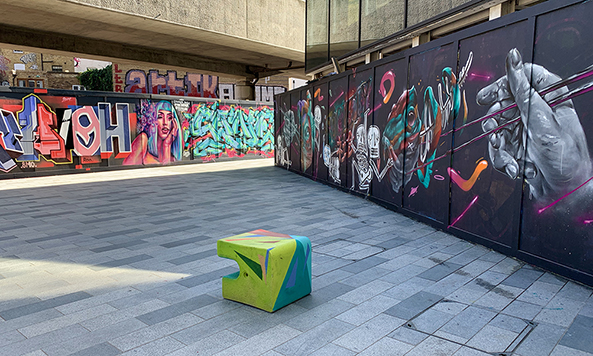
Figure 10. Image of an area in Shoreditch, United Kingdom
Photograph: A. Beattie, September 2019
As discussed, a gallery space is mediated and anticipated – something that can also be reflective for audiences attending street art tours. The audience is expecting to see street art and therefore the engagement is anticipated. Again, like the gallery, a disruption can occur but the physicality and context are different. Audiences wanting to engage with the art forms can use street art tours to activate areas.
I visited the suburb of Shoreditch, UK in September 2019, and experienced how street art and graffiti have activated the urban landscape and made it a hub for tourists. I went on a free mid-week street art tour that included 30 people. I engaged in a conversation with the tour guide during this trip and he said that there was a balance between artists and visitors. Artists would keep coming back to Shoreditch to paint and change the urban environment with new imagery, creating excitement for the audience. The tour guide was pleased with this for it allows them to talk about different works every day (As per comms Strawberry Tour guide September 2019). Combined, the tours and the artists are creating a snowball effect for people wanting to visit and experience the area.
Street art has the potential to creates a disruption of the everyday. This moment creates audience engagement and encourages them to see the world differently: the city becomes a canvas full of political and social commentary. When the audience is disrupted, a threshold moment can be created as the audience interacts with the artwork. This interaction with urban space is how street art can be used as a way of activating urban areas. The initial disruption occurs that potentially brings people to further engage with street art, and it is through the tours and the use of the internet that the physical space is further activated. These interactions are then used by audiences to engage on additional levels. This is evident through the use of social media and attending street art tours. By utilising street art, an area can benefit from the engagement, and place a focus of how people interact with the urban space. These disruptions assist in audience engagement, enable interactions to occur within the setting and add value to where the artwork is situated, creating an activation of space.
Case study: Laramie, Wyoming
While I will specifically discuss the example of Laramie, the use of public art throughout Wyoming itself is common. The town of Casper, for example, has multiple sculptures scattered in and around the town, including various mural commissions. Cody, a town near the Yellowstone National Park east entrance, has multiple bison sculptures throughout the downtown. There is a vibrant public art culture throughout the state.
Laramie is the fourth largest community in the state (‘Wyoming, USA: State specific information,’ n.d). In comparison to other towns, ‘community boosters’ and local government officials want Laramie to be known as the Cultural Capital of Wyoming (Laramie Public Art, n.d). I will look at Laramie specifically as a case study of the type of activation of space. According to the Laramie Public Art plan, one of the top ten principles to be implemented is:
The Laramie Public Art Inaugural Plan is reinforced by a surge of community interest in diverse forms of art that involve visual, performing and literature artists. Surveys and in person interviews confirmed that people in Laramie see public art as an important part of a vibrant community (Piechocki, McGregor &Thompson, 2015, p. 6).
The Laramie Mural Project, a grassroots idea designed to connect culturally and intellectually the local artists and community who enjoyed the public spaces presented in the historic district, aimed to reflect Laramie’s cultural and place-based assets. The project developed after the University of Wyoming Art Museum was to be closed for a period of time and the then Director, Susan Moldenhauer, wanted to continue the accessible art experience for the local community despite the closure. What started out as a public art engagement program, dispersed art throughout the town during the art museum’s temporary closure. When the public art exhibition finished, the community wanted more, and so the mural project began. In 2011, the Museum and Laramie Main Street, a non-profit dedicated to the revitalisation of Laramie’s historic district, collectively began working alongside artists, building owners and community members, to create a mural project that was to answer the question, ‘What do you love about Laramie?’. The project was created to support local artists as well as create a vibrant downtown. (Pers comms with Trey Sherwood, Executive Director Downtown Laramie, 16 January 2020).
According to a statement by the Laramie Public Art Coalition:
Because public art is freely accessible to all and located in the public sphere, it enhances people’s experiences of public places and provides opportunities for building community and connections. Public art is not just about paintings on a wall – it’s about bringing art to every aspect of the community, giving community members a voice in their public space, respecting artists and the profession, and working together with artists to create cultural experiences that reflect the vibrancy and richness of our great community (Laramie Public Art, n.d).
The artworks selected for this project have been designed to keep the concept and ideas of the community in focus: to create works that reflect the unique cultural, social, and outdoor amenities that exist within Laramie. This specific focus captured and celebrated the community and was collectively executed by the organising committee and local artists, creating networks through engagement, mentoring and sharing of ideas and practice.
The project also included a website http://www.laramiemuralproject.org/ that contained videos and information about the project and a self-guide map for audiences to download to navigate the town. When the project originally launched, a phone number was provided for the viewer to call and hear the artist speak about their mural, creating engagement with the audience to further to understand what they are viewing whilst being in this outdoor gallery space. This changes how audiences view the work and creates an activation of space.
A Facebook page, Laramie Mural Project, was established and the Instagram hashtags included #laramiemuralproject and #laramiemurals were posted by members of the community. The audience responded by sharing and liking images of the murals and contributing to the conversations that were occurring online with the artists. This created engagement between the audience, artwork and artists.
Below are examples of five works that can be seen in downtown Laramie. The images I selected capture the sense of history and community that the project aimed for. I will also briefly outline information about the artworks.
The mural in Figure 11 is next to the local food co-op, Big Hollow, and the artist wanted to create an artwork that represented workers’ freedom and rights within the community (University of Wyoming Art Museum, 2013). Big Hollow is important to the local community because it sells a great deal of local produce and is a hub of local events. The image is of a farmer and the idea is to look at how the land needs to be represented and the community members need to support each other.
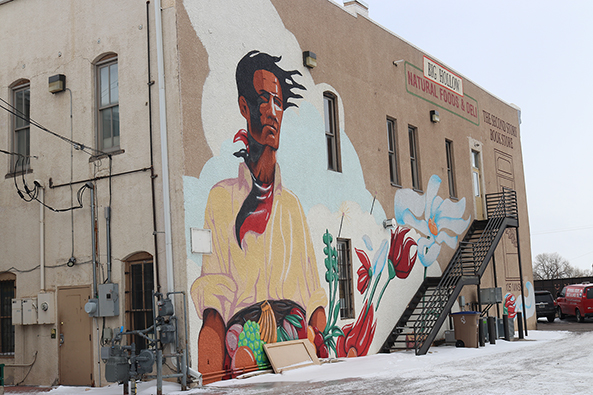
Figure 11. Tierra y Libertad (Land and Liberty), 2011
Artist: Talal Cockar
Photograph: A. Beattie, February 2020
The artist talked about the mural in Figure 12 as representing the Laramie community (University of Wyoming Art Museum, 2013). While Laramie is surrounded by national parks and striking mountains, the downtown area is filled with buildings and natural environment. This representation of the trees all together and the roots growing down far in the ground is likened to the community of people in Laramie and their connection to the local nature beyond the town centre. To the right there is a lone tree; this represents people not tied to the community and how their roots are not as big as the others.
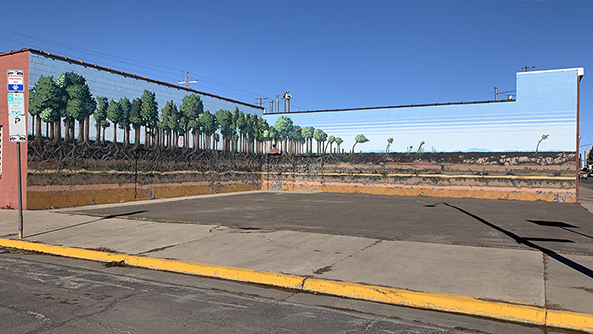
Figure 12. Growth, 2012
Artist: Dan Toro
Photograph: A. Beattie, January 2020
Figure 13 is an abstract mural that contains a representation of the mountain ranges of the local areas and the trees that sit within this space. There is a tree riding a bike and this emphasises how Laramie’s surrounding areas are filled with bike and hiking tracks, and as a visitor or local you are close to outdoor adventures; including hiking, biking, skiing, snow shoeing and climbing. All year around, nature provides this small town with recreational opportunities.
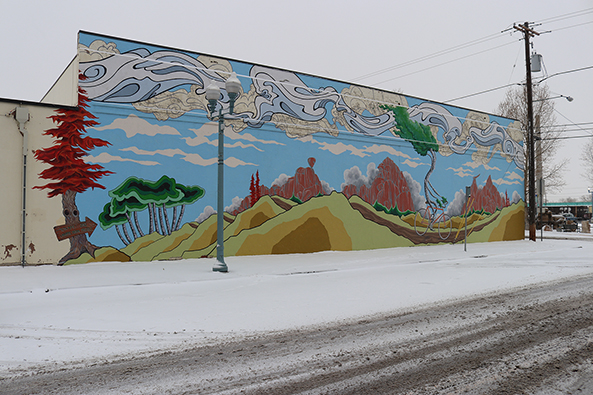
Figure 13. Escape, 2012
Artist: Meghan Meier
Photograph: A. Beattie, January 2020
The artwork shown in Figure 14 and Figure 15 was a collaboration between the artist and the community. The artist designed the mural and then requested community members to assist in developing the work by painting specific sections – a practice known as ‘paint by numbers’. This allowed a collaboration between the artist and the community. In many ways this artwork captures the broader intent of the Downtown Laramie project.
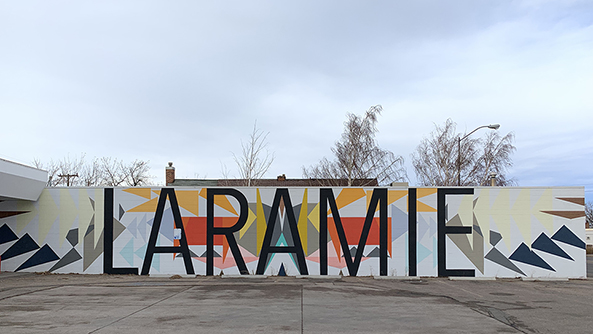
Figure 14. Laramie, 2017
Artist: June Glasson and the local community
Photograph: A. Beattie, January 2020
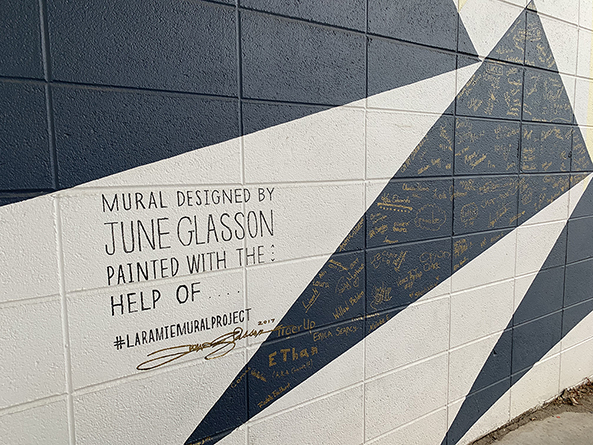
Figure 15. Laramie, 2017
Artist: June Glasson and the local community
Photograph: A. Beattie, January 2020
Laramie also has a Free Wall (Laramie public Art, n.d) (see Figure 16). The wall was established to entice artists to create works and begin their practice by having a piece of public space available for artists to use – much like the example of Victorian tourism and the use of Hosier Lane. This laneway is an available space where artists can create works in a safe and collaborative environment.
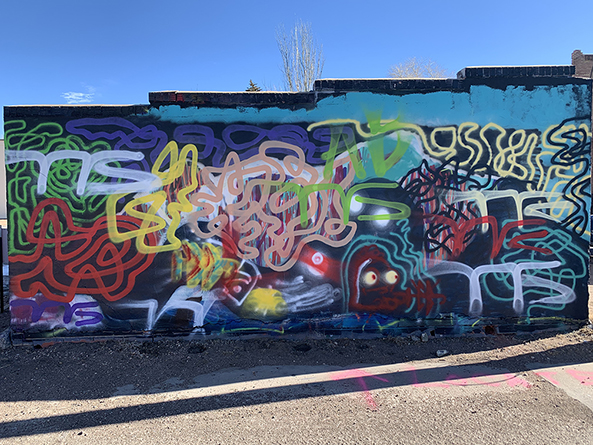
Figure 16. Image of Laramie’s Free Wall, Laramie, Wyoming, USA.
Photograph: A. Beattie, January 2020
The examples that I have selected all represent the importance of nature and living within Wyoming, and the town itself. As Laramie does not rely on extractive industries, the community focuses on the natural environment, tourism and service industries. What the murals fail to address is the contradiction that states like Wyoming, and nations like Australia, confront as their wealth is continues to be built from mining. Consequently, we can speculate what the town would look like if extractive industries were relied on. Would these murals be different? Would they be the same or would other issues be addressed?
As a resident of Laramie for over ten months, the murals captured my attention immediately as I was exploring the town, creating a disruption in my own experience. This small town, in a conservative state in the USA, understood the complex issues and history of its area – in other words, the surface level expectations of living in a small town in the US were overturned in part by my experience of street art. The artwork that most captured my attention was a stencil located in a back alley off the main street of downtown Laramie (see Figure 17). The artwork is of The Black 14, a football team that was stood down by the University of Wyoming football coach for wanting to wear black arm bands to protest against racism in 1969.
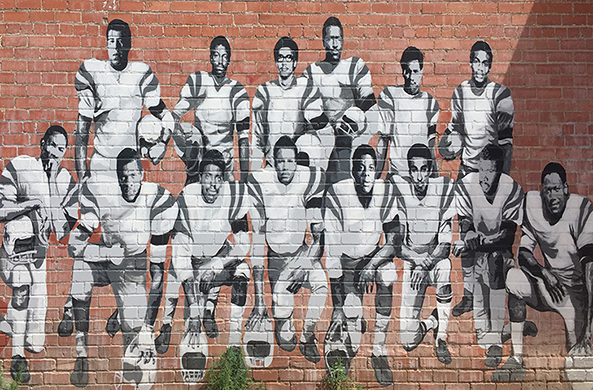
Figure 17. The Black 14
Artist: Adrienne Vetter
Photograph: A. Beattie, January 2020
These murals engaged my curiosity and encouraged me to want to know more: I crossed the threshold, wanting more information. I wanted to engage with the local area whilst walking the streets, viewing various artworks which sit both on the main streets and the back alleys. I wanted to engage with the town through exploring and interacting with the space. Social media also helped my search, for I was able to find these images and then search by the hashtags, such as #laramie #downtownlaramie. It was through such engagement that I was able to explore the social and economic aspects of the town including the retail and service sector. This process created my own experience of disruption, whereby I moved from seeing a small town in the west to one brimming with artists, activists and complex communities.
Can street art activate urban areas?
There are multiple ways street art can activate the environment and as this paper has outlined, there are a broad range of arguments to suggest that the activation of neighbourhoods can be both negative and positive. It is clear, however, that the outcomes in Laramie have been beneficial to the community. It is important to note that in a town as small as Laramie, it is exciting to see the community and local artists coming together and using street art to activate their downtown. This is important and a key aspect helping local businesses thrive in this small town in the middle of America and changing the nondescript downtown into a colourful reflective outdoor gallery space for all to enjoy.
The role of the murals can be unpacked in multiple ways: firstly, to provide public art for the community to enjoy; and secondly, to bring together the local artists to collaborate and share ideas regarding the theme ‘bringing it back to the community’. Thirdly, reflecting a theme evident throughout this paper, murals are a way for artists to communicate their political and social perspectives.
Christensen & Thor (2017) draw on the concept of reciprocity through street art and how works are created across the world, whether it be local or global, and how different ideas are exchanged that are mutually beneficial to the artists and community. They state that:
Our results indicate that street art and graffiti demonstrate solidaritarian place-making. The city as a site is generative simultaneously of conservation reinscription and cosmopolitan reciprocity, where reciprocity references claims to collective material and symbolic goods (Christensen et al., 2017, p. 587).
This understanding reflects on the practices of street art and how exchanges of the city and the art create an intellectual, as well as artistic, vibrancy within the urban environment. The reciprocity of the creation of the works exists and the exchange of knowledge and collaboration is evident with both the artists and the community involved. This reciprocity is evident within the Laramie murals for the artworks, though created years apart, align with the original idea of ‘What do you love about Laramie?’. Through the imagery, the collaboration produced by each artist is continued.
Further, Andron (2018) noted how street art tours alter the way that we engage with a town. Like Laramie, pop-up guided and self-guided art tours in and around the town centre, encourages people to look around and walk and see what is around in their local neighbourhoods. This is a fundamental way that we can encourage a sense of reciprocity of street art with the local community (Christenson & Thor, 2017). The art form in itself is encouraging the way that we interact and use street art to inspire the community and encourage the activation of these small towns.
By using the case study of Laramie Wyoming, we can begin to understand how street art, specifically murals, have the capacity to activate urban areas. Engagement is evidenced by the creation of an outdoor exhibition space that provides access to the public to find out more information about the artworks. Audiences had access to a telephone number and could listen to the artist explain the context of the mural – much like the audio guides used in gallery settings. Further, audiences are exposed to the local businesses within these downtown areas through the use of the self-guided art tours. The downtown area is activated by bringing the art out into the open and providing information that was once confined to the traditional gallery setting and creating a new space for audiences to explore.
Conclusion
This paper has argued that the Laramie Mural project has created a vibrant and activated downtown. Like other cities and neighbourhoods, the project has created a sense of reciprocity that has altered the relationship that both visitors and local community members have with the town and artists (both local and those from outside Wyoming). Laramie has created an example of how we can use art in the urban environment and how communities can benefit from this art form.
This paper is part of the broader research project related to my Doctor of Creative Arts that is investigating how street art can be used as a way of activation, through space and engagement. Different media, including online videos, essays and social media, can enable access the knowledge of the artists. Specifically, I ask if there a need for more information that can be provided to audiences to expand both the engagement and reciprocity. I explore how audiences can be engaged, without the limitations of gallery spaces, when art is brought into the urban environment and disrupts our daily experiences.
References
Andron, S. (2018). Selling streetness as experience: The role of street art tours in branding the creative city. The Sociological Review, 66(5), 1036-1057. doi:10.1177/0038026118771293.
Arvanitakis, J., & Beattie, A. (2019). Power, politics and art. Open Forum. Retrieved from https://www.openforum.com.au/power-politics-and-art-in-bondi/
Baird, J. A., & Taylor, C. (2016). Ancient Graffiti. In J. I. Ross (Ed.), Routledge handbook of graffiti and street art (pp. 17-26). Florence, Kentucky USA: Taylor and Francis.
Beattie, A. (2017). Women on walls: Engaging street art through the eyes of female artists. ProQuest Dissertations Publishing. Western Sydney University.
Bentley, R. (2015). Cutback. (PhD thesis). Western Sydney University.
Biedarieva, S. (2016). The street artist as translator. Space and Culture, 19(1), 4-14. doi:10.1177/1206331215579752.
Blanché, U. (2015). Street art and related terms: discussion and working definition. Street art & Urban Creativity Scientific Journal, 29, 32-38.
Bombing science. (2017, December 22). 60 Graffiti and street art tours around the world [Blog post]. Retrieved 15 November 2019 Available from, https://www.bombingscience.com/graffiti-street-art-walking-tours-around-world/
Brighenti, A. M. (2016). Graffiti, street art and the divergent synthesis of place valorisation in contemporary urbanism. In J. I. Ross (Ed.), Routledge handbook of graffiti and street art (pp. 247-259). Florence, UK: Taylor and Francis.
Brown, B. A. (2015). Digitized street art. In F. T. Marchese (Ed.), Media Art and the Urban Environment (Vol. 5, pp. 267-284). Switzerland: Springer, Cham.
Carroll, N. (1999). Philosophy of art a contemporary introduction New York: Routledge.
Chmielewska, E. (2007). Framing [Con]text: Graffiti and place. Space and Culture, 10(2), 145-169. doi:10.1177/1206331206298545.
Christensen, M., & Thor, T. (2017). The reciprocal city: Performing solidarity: Mediating space through street art and graffiti. International Communication Gazette, 79(6-7), 584-612. doi:10.1177/1748048517727183.
City of Melbourne. (n.d). Retrieved from, https://www.melbourne.vic.gov.au/arts-and-culture/art-outdoors/Pages/street-art.aspx
Dickens, L. (2008). Placing post-graffiti: The journey of the Peckham Rock. Cultural Geographies, 15(4), 471-496. doi:10.1177/1474474008094317.
Drew, P. (2012). A meme is born: The repetitive patterns of street art. Artlink, 32(1), 40-42.
Funk, J. (2019, December 11). Laramie toasts Wyoming’s women on 150th anniversary of suffrage. Laramie Boomerang Retrieved from https://www.laramieboomerang.com
Flessas, T., & Mulcahy, L. (2018). Limiting law: Art in the street and street in the art. Law, Culture and the Humanities, 14(2), 219-241. doi:10.1177/1743872115625951.
Hansen, S., & Danny, F. (2015). ‘This is not a Banksy!’: Street art as aesthetic protest. Continuum, 1-15. doi:10.1080/10304312.2015.1073685.
Heidegger, M. (1927/1962). Being and time, [trans. J. Macquarrie & E. Robinson]. New York: Harper & Row.
Iveson, K. (2010). The wars on graffiti and the new military urbanism. City, 14(1-2), 115-134. doi:10.1080/13604810903545783.
Jenkins, H., Ford, S., & Green, J. (2013). Spreadable media: Creating value and meaning in a networked culture. New York: NYU Press.
Laramie Main Street. (n.d). Retrieved 13 December 2019 from https://laramiemainstreet.org/mainstreet
Laramie Public Art. (n.d). Retrieved from, https://www.laramiepublicart.org/
Macdonald, N. (2001). The graffiti subculture: Youth, masculinity and identity in London and New York. Basingstoke, UK: Palgrave, Macmillan.
Macdowall, L., & de Souza, P. (2018). ‘I’d Double Tap That!!’: Street art, graffiti, and Instagram research. Media, Culture & Society, 40(1), 3-22. doi:10.1177/0163443717703793.
McAuliffe, C. (2012). Graffiti or street art? Negotiating the moral geographies of the creative city. Journal of Urban Affairs, 34(2), 189-206. doi:10.1111/j.1467-9906.2012.00610.x.
O’Doherty, B. (1986). Inside the white cube: The ideology of the gallery space. Santa Monica: Lapis Press.
Pariser, E. (2011). The filter bubble: What the Internet is hiding from you. London: Viking/Penguin Press.
Parisi, V. (2015). The sex of graffiti: Urban art, women and gender perception: Testing biases in the eye of the observer. Street Art & Urban Creativity Scientific Journal, 1(1), 53-62.
Piechocki, R., McGregor, J., &Thompson, M. (2015) Laramie Public Art Inaugural Plan. Retrieved from https://static1.squarespace.com/static/54a1a304e4b0f8d712cf4a73/t/564234eee4b00b392cc5fcfd/1447179502916/Laramie_PAPlan_Web.pdf.
Ross, J. I., Bengtsen, P., Lennon, J. F., Phillips, S., & Wilson, J. Z. (2017). In search of academic legitimacy: The current state of scholarship on graffiti and street art. The Social Science Journal, 54(4), 411-419. doi:10.1016/j.soscij.2017.08.004.
Smith, R. (2020, February 11). Hosier Lane ‘vandalism’ divides: Criminal act or part of the culture? News.com, Retrieved from, https://www.news.com.au/national/victoria/news/hosier-lane-vandalism-divides-criminal-act-or-part-of-the-culture/news-story/019da5ad6b95a6ec70b3a29a119605d8
Steiner, G. (1978). Heidegger London, UK: Fontana.
Suri, C. (2020, May 1). Street art confronts the pandemic. The New York Times, Retrieved from https://www.nytimes.com/2020/05/01/travel/coronavirus-street-art.html?searchResultPosition=1
Ten Eyck, T. A. (2016). Justifying graffiti: (Re)defining societal codes through orders of worth. The Social Science Journal, 53(2), 218-225. doi:10.1016/j.soscij.2014.11.007.
Ulmer, J. B. (2017). Writing Urban Space: Street Art, Democracy, and Photographic Cartography. Cultural Studies ↔ Critical Methodologies, 17(6), 491-502. doi:10.1177/1532708616655818.
University of Wyoming Art Museum. (2013, February 5). Laramie mural project [Video file]. Retrieved from https://youtu.be/m-a6NXBck4M
Visit NSW. (n.d). Retrieved from https://www.visitnsw.com/destinations/south-coast/wollongong-and-surrounds/wollongong
Wollheim, R. (1970). Art and its objects Harmondsworth, UK: Penguin.
Wright, R. (2020, June 9). The Secret Project That Led to Black Lives Matter Murals Coast to Coast. The New Yorker, Retrieved from https://www.newyorker.com/news/news-desk/the-secret-project-that-led-to-black-lives-matter-murals-coast-to-coast
Wyoming, USA: State specific information. (2019) Retrieved from, https://worldpopulationreview.com/countries/united-states-population/
Wyoming, USA: State specific information. (2018) Retrieved from, https://statisticalatlas.com/place/Wyoming/Laramie/Industries
Wyoming, USA: State specific information. (n.d) Retrieved from, https://www.geonames.org/US/WY/largest-cities-in-wyoming.html
Young, A. (2010). Negotiated consent or zero tolerance? Responding to graffiti and street art in Melbourne. City 14(1-2), 99-114. doi:10.1080/13604810903525215.
Young, A. (2013). Judging the image art, value, law. In M. McNeil, L. Pearce, & B. Skeggs (Eds.), Transformations: Thinking through Feminism (pp. 50 -74). Hoboken: Taylor and Francis.
Young, A. (2014). Street art, public city: Law, crime and the urban imagination. London, UK: Taylor & Francis Ltd.
Zuiderveen Borgesius, F., Trilling, D., Möller, J., Bodó, B., De Vreese, C., & Helberger, N. (2016). Should we worry about filter bubbles? Internet Policy Review, Journal on Policy Regulation 5(1).
About the author
Alix Beattie is undertaking a Doctor of Creative Arts at Western Sydney University. She holds a Bachelor of Arts and Master of Research. With eight-years’ experience working in a Sydney-based contemporary art gallery, her interests focus on the open-air exhibition spaces of street art in contrast to the reified ‘white cube’ of formal galleries. Her research has a specific focus on female artists and investigates how street art creates a disruption of thought and how audiences interact and respond.

